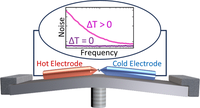Publication Date: January 30, 2024
Authors: Ofir Shein-Lumbroso, Matthew Gerry, Abhay Shastry, Ayelet Vilan, Dvira Segal, and Oren Tal.
Abstract:
Electronic flicker noise is recognized as the most abundant noise in electronic conductors, either as an unwanted contribution or as a source of information on electron transport mechanisms and material properties. This noise is typically observed when a voltage difference is applied across a conductor or current is flowing through it. Here, we identify an unknown type of electronic flicker noise that is found when a temperature difference is applied across a nanoscale conductor in the absence of a net charge current or voltage bias.
The revealed delta-T flicker noise is demonstrated in molecular junctions and characterized using quantum transport theory. This noise is expected to arise in nanoscale electronic conductors subjected to unintentional temperature gradients, where it can be a performance-limiting factor. On the positive side, delta-T flicker noise can detect temperature differences across a large variety of nanoscale conductors, down to atomic-scale junctions with no special setup requirements.
Related links

